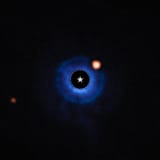Search Results
6/26/2025, 8:28:46 AM
>New Discovery: A Sub‑Jovian Planet Imaged by Webb in the TWA7 Debris Disk
https://www.nature.com/articles/s41586-025-09150-4
A new study in Nature (June25,2025) reports the first-ever direct detection of a sub‑Jovian exoplanet—named TWA7b—within the debris disk of the young (≈6.4Myr), nearby star TWA7 (∼110 light‑years away). Using JWST’s MIRI instrument paired with a French-designed coronagraph, the team captured thermal‑infrared imagery revealing a point source inside a gap between the disk’s rings.
>Key highlights
>Mass estimated around 0.3MJup (~100 Earth masses), with a temperature near 320K, positioning it between Neptune and Jupiter.
>Orbits ~52AU from its host star, consistent with models predicting planet–disk interactions that shape debris rings.
>Represents the lightest planet directly imaged by JWST to date, marking a milestone in the study of young, cold exoplanets.
>Demonstrates JWST’s coronagraphic capabilities, offering a path forward to imaging even smaller, more Earth-like worlds in protoplanetary environments.
>Implications
TWA7b offers a rare opportunity to study in action how emerging planets carve structures in their natal disks. This detection paves the way for using thermal‑infrared imaging to trace the formation of lower‑mass exoplanets still embedded within debris disks.
https://www.nature.com/articles/s41586-025-09150-4
A new study in Nature (June25,2025) reports the first-ever direct detection of a sub‑Jovian exoplanet—named TWA7b—within the debris disk of the young (≈6.4Myr), nearby star TWA7 (∼110 light‑years away). Using JWST’s MIRI instrument paired with a French-designed coronagraph, the team captured thermal‑infrared imagery revealing a point source inside a gap between the disk’s rings.
>Key highlights
>Mass estimated around 0.3MJup (~100 Earth masses), with a temperature near 320K, positioning it between Neptune and Jupiter.
>Orbits ~52AU from its host star, consistent with models predicting planet–disk interactions that shape debris rings.
>Represents the lightest planet directly imaged by JWST to date, marking a milestone in the study of young, cold exoplanets.
>Demonstrates JWST’s coronagraphic capabilities, offering a path forward to imaging even smaller, more Earth-like worlds in protoplanetary environments.
>Implications
TWA7b offers a rare opportunity to study in action how emerging planets carve structures in their natal disks. This detection paves the way for using thermal‑infrared imaging to trace the formation of lower‑mass exoplanets still embedded within debris disks.
Page 1
